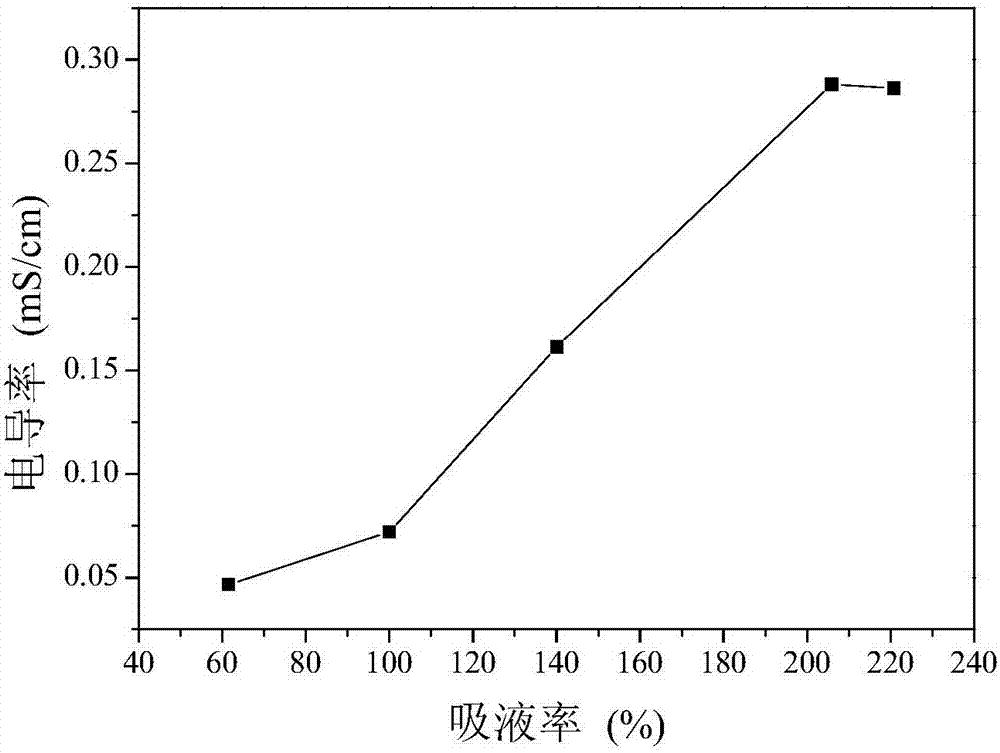A kind of preparation method of thermally cross-linkable polymer electrolyte membrane for lithium battery
A technology of cross-linked polymer and electrolyte membrane, which is used in the manufacture of electrolyte batteries, non-aqueous electrolyte batteries, battery pack components, etc. The effects of controlled growth, fast polymerization speed and wide range of monomer composition
- Summary
- Abstract
- Description
- Claims
- Application Information
AI Technical Summary
Problems solved by technology
Method used
Image
Examples
preparation example Construction
[0022] The preparation method of the heat-crosslinkable polymer electrolyte membrane of the present invention comprises the following steps:
[0023] (1) 0.5-2.6 parts by weight of amphiphilic macromolecular reversible addition fragmentation chain transfer reagent is stirred and dissolved in 30-80 parts by weight of water to form an aqueous phase, and then mixed with 7.6-19 parts by weight of St and 0.076-0.95 parts by weight The oil phase composed of parts Ip is poured into the reactor together and stirred and mixed; the reaction temperature is raised to 60-80 ° C, kept stirring, nitrogen deoxygenation is carried out for 5-30 minutes, and 0.005-0.05 parts by weight of water-soluble initiator is added to polymerize After 1-2 hours, get R-AA n1 -b-St n2 -b-(St-co-Ip) n3 -X block copolymer, R-AA n1 -b-St n2 -b-(St-co-Ip) n3 -X block copolymers are stably dispersed in water in the form of particles to form latex;
[0024] (2) Add 13-30 parts by weight of MA monomer and 25-5...
Embodiment 1
[0049] R-AA n1 -b-St n2 -b-(St-co-Ip) n3 -b-MA n4 -b-(St-co-Ip) n5 -X block copolymer, wherein (St-co-Ip) n3 -b-MA n4 -b-(St-co-Ip) n5 The designed molecular structure of the block copolymer is 25K-40K-25K, and the monomer mass ratio of St to Ip is 100:1:
[0050] (1) 1.0 parts by weight of the amphiphilic macromolecular reversible addition fragmentation chain transfer reagent is stirred and dissolved in 40 parts by weight of water to form a water phase, and then poured together with the oil phase consisting of 10 parts by weight of St and 0.1 parts by weight of Ip Stir in the reactor to mix. Raise the reaction temperature to 70°C, keep stirring, pass nitrogen to remove oxygen for 15 minutes, add 0.024 parts by weight of a water-soluble initiator, and polymerize for 1.5 hours to obtain R-AA n1 -b-St n2 -b-(St-co-Ip) n3 -X block copolymer, R-AA n1 -b-St n2 -b-(St-co-Ip) n3 The -X block copolymer is stably dispersed in water in the form of particles to form a latex....
Embodiment 2
[0061] R-AA n1 -b-St n2 -b-(St-co-Ip) n3 -b-MA n4 -b-(St-co-Ip)n5 -X block copolymer, wherein (St-co-Ip) n3 -b-MA n4 -b-(St-co-Ip) n5 The designed molecular structure of the block copolymer is 17K-30K-17K, and the monomer mass ratio of St to Ip is 100:1:
[0062] (1) 2.4 parts by weight of the amphiphilic macromolecular reversible addition fragmentation chain transfer reagent is stirred and dissolved in 40 parts by weight of water to form a water phase, and then poured together with the oil phase consisting of 10 parts by weight of St and 0.1 parts by weight of Ip Stir in the reactor to mix. Raise the reaction temperature to 70°C, keep stirring, pass nitrogen to remove oxygen for 25 minutes, add 0.046 parts by weight of a water-soluble initiator, and polymerize for 2 hours to obtain R-AA n1 -b-St n2 -b-(St-co-Ip) n3 -X block copolymer, R-AA n1 -b-St n2 -b-(St-co-Ip) n3 The -X block copolymer is stably dispersed in water in the form of particles to form a latex.
...
PUM
| Property | Measurement | Unit |
|---|---|---|
| depth | aaaaa | aaaaa |
| thickness | aaaaa | aaaaa |
| electrical conductivity | aaaaa | aaaaa |
Abstract
Description
Claims
Application Information
 Login to View More
Login to View More - R&D
- Intellectual Property
- Life Sciences
- Materials
- Tech Scout
- Unparalleled Data Quality
- Higher Quality Content
- 60% Fewer Hallucinations
Browse by: Latest US Patents, China's latest patents, Technical Efficacy Thesaurus, Application Domain, Technology Topic, Popular Technical Reports.
© 2025 PatSnap. All rights reserved.Legal|Privacy policy|Modern Slavery Act Transparency Statement|Sitemap|About US| Contact US: help@patsnap.com



